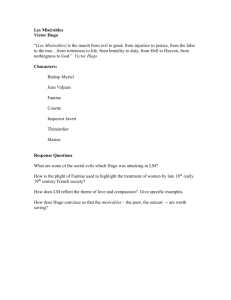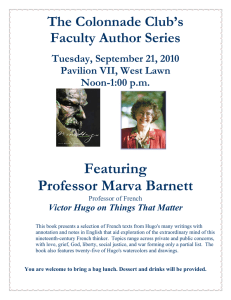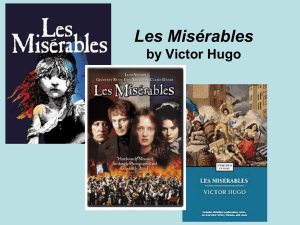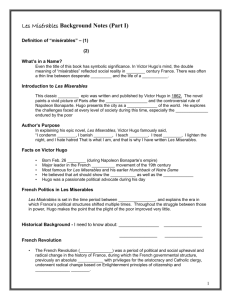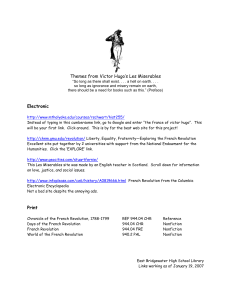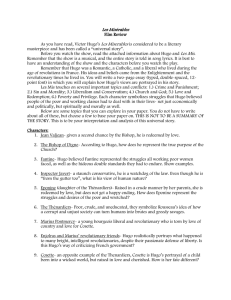Les Misérables Introduction
advertisement
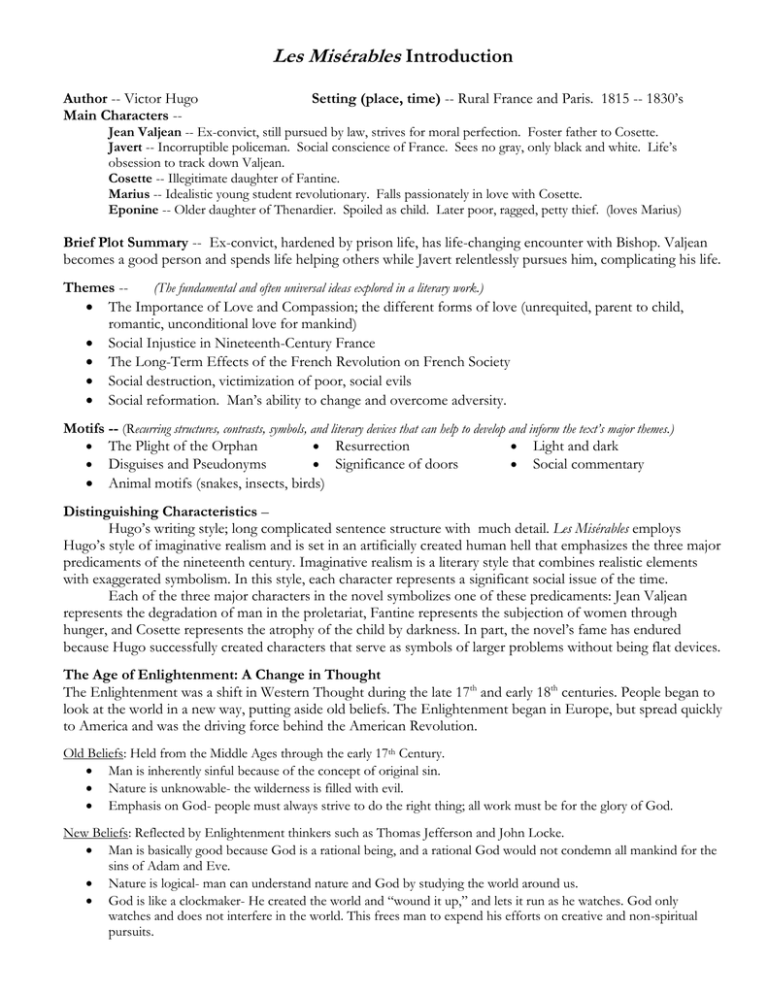
Les Misérables Introduction Author -- Victor Hugo Main Characters -- Setting (place, time) -- Rural France and Paris. 1815 -- 1830’s Jean Valjean -- Ex-convict, still pursued by law, strives for moral perfection. Foster father to Cosette. Javert -- Incorruptible policeman. Social conscience of France. Sees no gray, only black and white. Life’s obsession to track down Valjean. Cosette -- Illegitimate daughter of Fantine. Marius -- Idealistic young student revolutionary. Falls passionately in love with Cosette. Eponine -- Older daughter of Thenardier. Spoiled as child. Later poor, ragged, petty thief. (loves Marius) Brief Plot Summary -- Ex-convict, hardened by prison life, has life-changing encounter with Bishop. Valjean becomes a good person and spends life helping others while Javert relentlessly pursues him, complicating his life. Themes -(The fundamental and often universal ideas explored in a literary work.) The Importance of Love and Compassion; the different forms of love (unrequited, parent to child, romantic, unconditional love for mankind) Social Injustice in Nineteenth-Century France The Long-Term Effects of the French Revolution on French Society Social destruction, victimization of poor, social evils Social reformation. Man’s ability to change and overcome adversity. Motifs -- (Recurring structures, contrasts, symbols, and literary devices that can help to develop and inform the text’s major themes.) The Plight of the Orphan Resurrection Light and dark Disguises and Pseudonyms Significance of doors Social commentary Animal motifs (snakes, insects, birds) Distinguishing Characteristics – Hugo’s writing style; long complicated sentence structure with much detail. Les Misérables employs Hugo’s style of imaginative realism and is set in an artificially created human hell that emphasizes the three major predicaments of the nineteenth century. Imaginative realism is a literary style that combines realistic elements with exaggerated symbolism. In this style, each character represents a significant social issue of the time. Each of the three major characters in the novel symbolizes one of these predicaments: Jean Valjean represents the degradation of man in the proletariat, Fantine represents the subjection of women through hunger, and Cosette represents the atrophy of the child by darkness. In part, the novel’s fame has endured because Hugo successfully created characters that serve as symbols of larger problems without being flat devices. The Age of Enlightenment: A Change in Thought The Enlightenment was a shift in Western Thought during the late 17th and early 18th centuries. People began to look at the world in a new way, putting aside old beliefs. The Enlightenment began in Europe, but spread quickly to America and was the driving force behind the American Revolution. Old Beliefs: Held from the Middle Ages through the early 17th Century. Man is inherently sinful because of the concept of original sin. Nature is unknowable- the wilderness is filled with evil. Emphasis on God- people must always strive to do the right thing; all work must be for the glory of God. New Beliefs: Reflected by Enlightenment thinkers such as Thomas Jefferson and John Locke. Man is basically good because God is a rational being, and a rational God would not condemn all mankind for the sins of Adam and Eve. Nature is logical- man can understand nature and God by studying the world around us. God is like a clockmaker- He created the world and “wound it up,” and lets it run as he watches. God only watches and does not interfere in the world. This frees man to expend his efforts on creative and non-spiritual pursuits. The French Revolution In the 18th century, France was undergoing social and economic changes that undermined its old society, in which a very small minority of land-owning nobles, powerful churchmen, and absolutist kings had held total sway over the vast majority of French peasants and commoners. Facing a financial crisis in the 1780s, King Louis XVI consulted the Estates- General, a legislative body made up of three groups of French society. The Third Estate, made up of commoners, promptly demanded fundamental changes toward creating a new constitution and limiting the monarchy. When the First and Second Estates, consisting of the clergy and nobility respectively, objected to losing their privileges, the Third Estate proclaimed itself the National Assembly. Revolutionary fervor boiled over on July 14, 1789 as Parisians stormed the Bastille prison, sparking violent peasant uprisings throughout the country. In 1791, the king and Marie Antoinette were foiled in their attempt to escape to Austria, a move which cast doubt on their loyalty to France as Austria declared war to quell the revolution. Under the threat of treason and foreign invasion, the National Convention became the new national government in 1792, when it abolished the monarchy and declared France a republic. Louis XVI was convicted of treason and guillotined; Marie Antoinette later met the same fate. The moderate Girondins, then the radical Jacobins rose to power, culminating in the rule of Robespierre and the Reign of Terror in which thousands of suspected traitors were sent to the guillotine. After Robespierre’s death, the Directory was formed, which achieved some stability but had only tenuous control of the country. Napoleon, a powerful military general, staged a coup in 1799 and became the dictator and later emperor of France. His defeat at Waterloo in 1815 resulted in the official restoration of the French monarchy. While Napoleon made attempts at reform; it would take repeated conflicts between rich and poor throughout the 19thcentury to make the liberal ideals of the French Revolution a reality. 1780s — France is nearly bankrupt. 1788 —The Estates-General convenes. 1789 —The Third Estate declares itself the National Assembly 1789 —The Third Estate issues the Tennis Court Oath. 1789 — Bastille prison is stormed on July 14th. 1789 — March of the Women to Versailles. 1791 — Royal family attempts to escape to Austria. 1792 — France declares war on Austria. 1792 — Mobs attack the Tuileries Palace. TIMELINE 1792 — National Convention is established and the monarchy is abolished. 1793 — Louis XVI, and later Marie Antoinette, are guillotined. 1793–1794 —The Reign of Terror results in thousands of deaths. 1794 — Robespierre is guillotined. 1795 —The French Directory, made up of five directors, takes power. 1799 — Napoleon overthrows the Directory. 1804 — Napoleon declares himself the Emperor of France. 1814 —The French monarchy is restored; Louis XVIII becomes king. 1815 — Napoleon is defeated at Waterloo. Victor Hugo VICTOR HUGO was born in 1802 in the French town of Besançon. His father was a general in Napoléon’s army, and much of his childhood was therefore spent amid the backdrop of Napoléon’s campaigns in Spain and in Italy. At the age of eleven, Hugo returned to live with his mother in Paris, where he became infatuated with books and literature. By the time he was fifteen, he had already submitted one poem to a contest sponsored by the prestigious French Academy. France’s 1830 July Revolution opened Hugo’s creative floodgates, and he began producing a steady stream of work, most notably the novel The Hunchback of Notre-Dame (1831). Hugo also began to cultivate his interest in politics and was elected to France’s National Assembly after the revolution of 1848. As Hugo grew older, his politics became increasingly leftist, and he was forced to flee France in 1851 because of his opposition to the monarch Louis Napoléon. Hugo remained in exile until 1870, when he returned to his home country as a national hero. He continued to write until his death in 1885. He was buried with every conceivable honor in one of the grandest funerals in modern French history. Hugo began writing Les Misérables twenty years before its eventual publication in 1862. His goals in writing the novel were as lofty as the reputation it has subsequently acquired; Les Misérables is primarily a great humanitarian work that encourages compassion and hope in the face of adversity and injustice. It is also, however, a historical novel of great scope and analysis, and it provides a detailed vision of nineteenth-century French politics and society. By coupling his story of redemption with a meticulous documentation of the injustices of France’s recent past, Hugo hoped Les Misérables would encourage a more progressive and democratic future. Driven by his commitment to reform and progress, Hugo wrote Les Misérables with nothing less than a literary and political revolution in mind.
